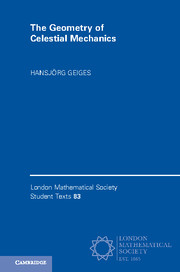Book contents
- Frontmatter
- Epigraph
- Contents
- Preface
- 1 The central force problem
- 2 Conic sections
- 3 The Kepler problem
- 4 The dynamics of the Kepler problem
- 5 The two-body problem
- 6 The n-body problem
- 7 The three-body problem
- 8 The differential geometry of the Kepler problem
- 9 Hamiltonian mechanics
- 10 The topology of the Kepler problem
- References
- Index
7 - The three-body problem
Published online by Cambridge University Press: 05 March 2016
- Frontmatter
- Epigraph
- Contents
- Preface
- 1 The central force problem
- 2 Conic sections
- 3 The Kepler problem
- 4 The dynamics of the Kepler problem
- 5 The two-body problem
- 6 The n-body problem
- 7 The three-body problem
- 8 The differential geometry of the Kepler problem
- 9 Hamiltonian mechanics
- 10 The topology of the Kepler problem
- References
- Index
Summary
It is quite a three pipe problem, and I beg that you won't speak to me for fifty minutes.
Arthur Conan Doyle, The Red-Headed LeagueWe now specialise to the case of three bodies moving under mutual gravitational attraction. In Section 7.1 we give a detailed proof of Lagrange's theorem on homographic solutions to the three-body problem. Lagrange's argument includes, in principle, the collinear solutions found earlier by Euler. For simplicity, however, we shall prove Lagrange's theorem under the assumption that the triangle formed by the three bodies is at all times non-degenerate. Then, in Section 7.2, we give a direct derivation of Euler's solutions under some simplifying assumptions. In Section 7.3 we derive various general results about the so-called restricted three-body problem, where one of the three masses is assumed to be negligibly small compared with the other two.
Lagrange's homographic solutions
In Section 6.6 we have given a complete description of the non-collinear planar homographic solutions of the three-body problem. The following theorem of Lagrange says that all non-collinear homographic solutions of the three-body problem are in fact planar, and hence of the form described earlier.
Theorem 7.1 (Lagrange) Let (r1, r2, r3) be a non-collinear homographic solution of the three-body problem, with centre of mass fixed at the origin. Then the following statements hold.
(i) The plane determined by the three bodies remains fixed in space.
(ii) The sum of the Newtonian forces acting on each of the three bodies is directed towards the origin.
(iii) The three bodies form an equilateral triangle.
(iv) The three bodies move on conic sections that are similar to one another, each having the origin as one of its foci.
Figure 7.1 shows such a homographic solution in the case of three equal masses, where the three conic sections are congruent. Figure 7.2 shows a relative equilibrium with three different masses moving on circles.
Remark 7.2 Lagrange's solutions to the three-body problem can be observed in nature. In the plane of Jupiter's orbit around the Sun, near the two points forming an equilateral triangle with Sun and Jupiter, there are large groups of asteroids known as the Trojans.
- Type
- Chapter
- Information
- The Geometry of Celestial Mechanics , pp. 77 - 100Publisher: Cambridge University PressPrint publication year: 2016

